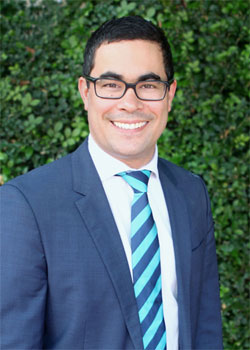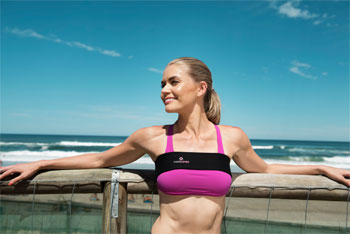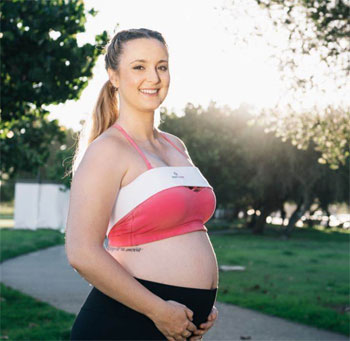Dr David Sharp Protect Your 'Breast' Assets Interview

Plastic Surgeon Says It Is Important to Protect Your -Breast' Assets
Did you know that it is common practice for women with large breasts to wear up to three bras just to go for a run?
Fed up with the lack of 'support,' an Australian woman has developed an activewear accessory that adds compression to women's breasts, giving the well-endowed a new lease on life.
The first-of-its-kind in Australia, the Pinkclover Breastband is a compression band that is placed across the top of the breasts, reducing vertical breast movement and strain. Made from breathable and durable fabric, the Breastband maximises comfort and support.
Plastic and Reconstructive Surgeon, Doctor David Sharp MBBS FRACS says breast reduction and breast lifts (mastopexy) surgeries are both in high demand in his clinics.
"We find patients who have large breasts often avoid exercise due to back and neck pain as well as skin irritations and chronic rashes that occur. This causes them to gain weight and continue on a merry-go-round of discomfort, inability to exercise, weight gain and increased breast size, which exacerbates the original issue" Dr. Sharp says.
Creator and founder of the PINKCLOVER Breastband, Amy Jaffers, says she designed the product to support the upper part of the breast and help reduce irreparable damage to fragile breast ligaments. Leading n active lifestyle without giving your breasts adequate support can not only cause pain but can also speed up breast sagging.
"While sports bras offer great support around the breast, they are not completely effective in reducing the upwards bounce," Ms. Jaffers says. "Pairing our Breastband with your favourite sports bra will ensure total all-round support allowing women to work out comfortably and confidently".
It's not just women with large breasts that are flocking to the product, post-partum mothers returning to exercise have found it beneficial, as it not only provides additional support to their sensitive breasts, but can also be worn over the top of maternity bras.
Women's breasts can grow up to 1.5 times the regular size when they are pregnant or breastfeeding. The Breastband is able to be placed over the top of any kind of bra so it can be worn all day, every day.
"The importance of good breast support cannot be underestimated in terms of short term comfort, and long-term health outcomes," Dr. Sharp says.
"While there are many excuses for exercise, your breasts shouldn't be one of them, I wanted to create a product that made women feel confident and protected while working out," Ms. Jaffers says.
 Interview with Plastic and Reconstructive Surgeon, Doctor David Sharp MBBS FRACS
Interview with Plastic and Reconstructive Surgeon, Doctor David Sharp MBBS FRACS
Question: Why are breast lifts so common in Australia, at the moment?
Dr David Sharp: Women are seeking breast reduction surgery in growing numbers, partly due to the increased accessibility of this procedure and awareness of its health benefits. Women also undergo breast lift surgery (which is called a 'mastopexy') to lift their breasts; rather than removing breast tissue and skin to reduce the breast size, a mastopexy removes excess skin to lift the breast and reposition the areola and nipple. Both procedures can reduce the skin irritations that come along with having redundant breast skin or excessive breast tissue rubbing against the adjacent chest skin and bra. Breast reduction surgery in particular can also significantly reduce back and neck pain that women experience when their breasts are very large.
Question: Can you tell us about the popularity surrounding breast reduction surgery?
Dr David Sharp: Further to the above information, demand for breast reduction and breast lift surgery is almost equal to demand for breast enlargement surgery in my clinics. These range from young women who feel incredibly self-conscious and physically hindered by the size of their breasts through to mothers who have skin laxity and ptosis (breast sagging) after breastfeeding – through to women who combine breast lift with an implant to lift and restore lost breast volume after weightloss or breastfeeding. They can be incredibly life changing procedures as they have functional, lifestyle-enhancing benefits as well as offering an aesthetic improvement that can help improve the relationship a woman has with her body.
Question: How does the Pinkclover Breastband help when women run?
Dr David Sharp: It assists with stabilising the breast during physical activity. During exercise, such as running or aerobics, women with large breasts or significant breast ptosis can find that the repeated impact and motion causes skin breakdown, strain on their breast tissue and some of my patients report bleeding and infection under their breasts, where the skin has rubbed during physical activity, causing it to split open. The breast band can assist women in reducing the physical impact of exercise on their breasts.
Question: Does the Pinkclover Breastband replace the fact some women wear three bras when going for a run?
Dr David Sharp: I can't clinically comment on the benefits as some high compression bras may be equivalent – but certainly any reduction in movement of breast tissue while running can only help!
Question: How often and when should pregnant women look to begin wearing the Pinkclover Breastband?
Dr David Sharp: As pregnant women experience significant breast changes during pregnancy that can be coupled with extreme sensitivity, I can't comment on whether or not a breast band would be appropriate specifically for their breasts. They should wear it if it makes them feel secure and supported.
 Question: When else should women be wearing the Pinkclover Breastband?
Question: When else should women be wearing the Pinkclover Breastband? Dr David Sharp: When prescribed by their treating surgeon, the band may also be useful for some women after breast augmentation surgery, if their implants are sitting high and require some gentle compression to help them sit more naturally, lower on the chest.
Question: How else can we protect our breasts?
Dr David Sharp: 1. Regular self-examination, once per month
2. Take note of any changes to breast shape, skin condition or nipple discharge and see your GP if you notice any of the these
3. Wear a supportive bra for everyday use, and save unsupportive underwear and lingerie for shorter periods of wear
4. Exercise is great for women and great for their breasts; women who exercise more are less likely to develop cancer, and also less likely to develop obesity related breast changes/carry excessive weight on their chest
5. Don't let large breasts, or breast ptosis, stop you from exercising. Use a supportive bra, and if required, additional support through the use of a breast band to stabilise your breasts and make exercise more comfortable. If breast discomfort still hinders your exercise routine, seek the advice of a FRACS qualified plastic surgeon to discuss your options.
Interview by Brooke Hunter
MORE



